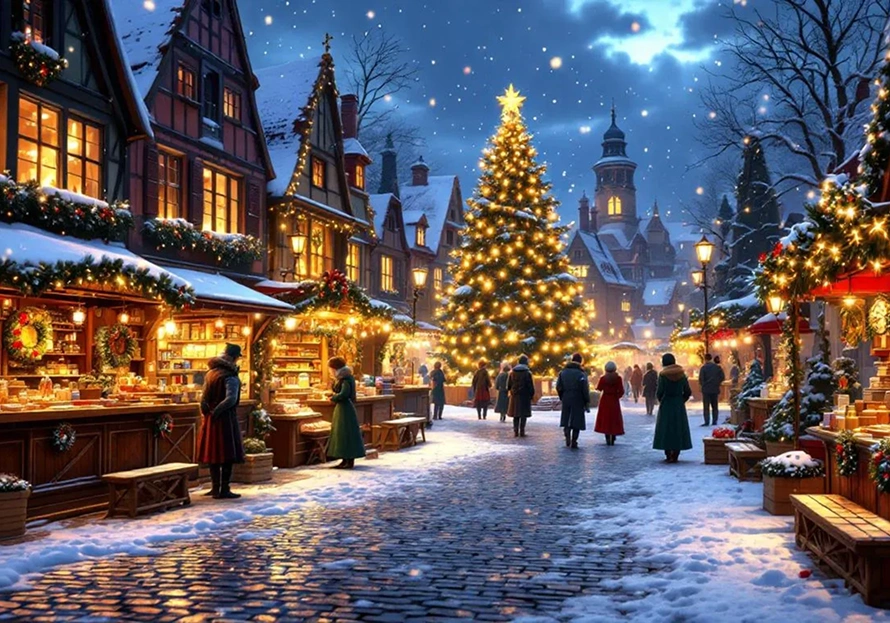Europe in winter offers unique experiences, from magical Christmas markets to snow-covered landscapes, but also presents challenges like cold weather and shorter days. Visiting Europe during the winter months is appealing for those seeking festive activities, fewer crowds, and the charm of historic cities dressed in winter lights, but it requires careful planning for weather and travel logistics.
Winters in Europe run from December to February with temperatures ranging from -10°C in Northern Europe to 15°C in Southern Europe. The weather in Europe is unpredictable during winters, so travelers should be prepared for sudden changes in weather conditions. Key tips include dressing in layers, choosing warm winter clothes, and planning for shorter daylight hours to make the most of your travel itineraries.
Europe Winter Packing Guide
Carry thermal layers, wool hats, scarves, gloves, and waterproof winter boots to stay warm and comfortable during cold winter days.
Include a warm winter coat and waterproof outerwear for rain or snow; bring a ski jacket if visiting ski resorts or the arctic circle.
Use packing cubes to organize luggage and save space, especially if packing carry-on only.
Pack versatile clothing like long sleeve shirts, warm socks, and comfortable walking shoes for varying weather.
Bring a day bag for essentials while exploring.
Consider cozy pajamas for chilly hotel rooms and a bathing suit if your accommodation has hot springs or a pool.
Dress in layers to adjust to changing temperatures and stay warm throughout the day.
Do laundry during your trip to pack lighter and keep your list manageable.
Carry a tote bag for shopping, laundry, or extra storage during your winter trip.
Best Winter Cities and Cheap European Winter Destinations
Some budget-friendly winter destinations include Lithuania, Slovenia (Maribor, Kranjska Gora), and parts of Eastern Europe where accommodation and food are affordable. Eastern European cities like Budapest and Prague offer beautiful winter landscapes, festive vibes, and popular winter activities such as ice skating. Exploring smaller towns and villages in winter can provide picturesque views and a peaceful atmosphere. Travelers should consider using public transportation options like trains and buses to save money while traveling in Europe during winter. Southern Europe offers milder weather, ideal for those wanting less harsh cold and a chance to enjoy a winter getaway with more winter sun.
Note: Knowing the best times to book to find cheap flights and save big can help you plan your winter vacation efficiently.
Europe Christmas Markets and Off-Season Travel
European Christmas markets are a highlight during winter, with vibrant markets in cities like Brussels, Vienna, Munich, and Prague. These run from mid-November to early January and are perfect for family-friendly sightseeing and shopping.
If you’re planning a Christmas market trip, remember to pack essentials like medicine for cold and flu, as winter travel and outdoor markets can expose you to chilly weather and seasonal illnesses.
Christmas markets and winter festivals are unique seasonal experiences available in Europe during winter months. Travelers can enjoy mulled wine and soak up the holiday spirit while taking advantage of fewer crowds and better deals on flights and hotels during the off season. Destinations like Italy and Portugal offer quieter, pleasant winter escapes where you can enjoy a nice dinner or cozy up with a hot drink.
Winter Travel Safety in Europe
Stay safe by planning transport disruptions like snow delays ahead. Keep belongings secure in crowded markets and use anti-theft bags. If skiing, always wear proper safety gear and follow local guidelines. Be cautious on icy roads if driving, opt for winter tires, and carry emergency supplies in your car. Keeping your phone charged and having offline maps downloaded is essential for navigation in winter. Travel insurance is recommended for winter trips to Europe to cover unexpected events. These winter travel safety Europe tips are essential for a worry-free holiday.
Staying Connected and Planning Your Itinerary
Use travel apps to monitor schedules and weather.
Plan to visit indoor attractions during short daylight hours, as winter is ideal for exploring museums and galleries due to fewer crowds.
Prioritize outdoor sightseeing in the morning and early afternoon during winter as daylight hours are shorter.
Define a clear itinerary prioritizing non-negotiable landmarks.
Check out the best places to travel during Christmas first, then dress suitably for sightseeing and stay hydrated despite cold weather.
When packing for many trips, it’s totally understandable to want to bring chunky sweaters and snow boots, but layering is still key.
Final Thoughts
Winter travel in Europe offers a magical experience with snowy streets, festive markets, and unique winter activities like ice skating and visiting hot springs. By packing smart with a well-planned Europe winter packing list, including warm boots, wool socks, and a reliable winter coat, you can enjoy your winter vacation comfortably. I absolutely love my insulated boots for their warmth and comfort—they make exploring in cold weather so much more enjoyable. Whether this is your first trip or you are a seasoned traveler, taking advantage of off-season prices and fewer crowds makes winter the perfect time to visit Europe.
Navigating the world of best flight deals is easier when you use reliable platforms like BookMyTrip to secure your travel arrangements. Following these tips is essential for surviving winter comfortably while traveling in Europe.
Frequently Asked Questions (FAQs)
Layer clothing with thermals, merino wool socks, and waterproof boots. Bring a warm coat, gloves, scarves, and hats. Use packing cubes and do laundry to save space.
Keep your phone charged with offline maps, share your itinerary, use anti-theft bags, avoid dark areas, and prepare for short daylight and weather changes.
Only if skiing, visiting the arctic circle, or spending lots of time in snow. Otherwise, thermals and waterproof boots suffice.
Enjoy Christmas markets, ice skating in cities like Prague and Vienna, northern lights, hot springs, and festive cafes.
Sightsee outdoors in the morning and early afternoon, visit museums later, and dress in layers with a hot drink to stay warm.






